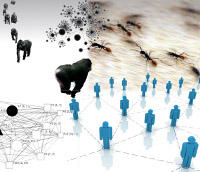Orateur
Dr
Cristian Pasquaretta
(Institut Pluridisciplinaire Hubert Curien)
Description
Efficiency of information transmission relies on a presence of a minimum triadic structure composed by a sender, a receiver and a transmission channel. Generally, if the sender and the receiver own a common communication code, the information detected would produce a reduction in the uncertainty of the receiver and a consequently change in its behaviour. In complex living system the minimum triadic structure needed for information transmission is usually replaced by a more complex structure where information can be obtained from several senders differently. A complex system where actors are connected each other can be easily described as a network system in which information flow among the actors following both random and, more often, non random movements. Here we introduce methods and preliminary results from a network analysis in Drosophila during information transmission trials. We automatically detected number of interactions, evolution of the contacts within the time and the utilization distribution of the arena where individuals (both senders and receivers) were recorded during experimental video tracking. We calculated and compared the most used network measures to detect their reliability in information transmission processes and we show how individual differences in exploration behaviour of the arena influence the number of interactions started and received by individuals.
Auteur
Dr
Cristian Pasquaretta
(Institut Pluridisciplinaire Hubert Curien)
Co-auteurs
Dr
Cédric Sueur
(Institut Pluridisciplinaire Hubert Curien)
Dr
Céline Moreno
(Laboratoire Évolution, Génomes et Spéciation, CNRS-UPS11)
Dr
Dominique Joly
(Laboratoire Évolution, Génomes et Spéciation, CNRS-UPS11)
Dr
Frédéric Méry
(Laboratoire Évolution, Génomes et Spéciation, CNRS-UPS11)
Mme
Marine Battesti
(Laboratoire Évolution, Génomes et Spéciation, CNRS-UPS11)
Dr
odile Petit
(Institut Pluridisciplinaire Hubert Curien)

